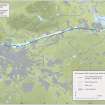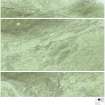Following the launch of trove.scot in February 2025 we are now planning the retiral of some of our webservices. Canmore will be switched off on 24th June 2025. Information about the closure can be found on the HES website: Retiral of HES web services | Historic Environment Scotland
Little Kerse
Long Cist(S) (Early Medieval), Temporary Camp (Roman)
Site Name Little Kerse
Classification Long Cist(S) (Early Medieval), Temporary Camp (Roman)
Canmore ID 47872
Site Number NS97NW 12
NGR NS 94335 78900
Datum OSGB36 - NGR
Permalink http://canmore.org.uk/site/47872
- Council Falkirk
- Parish Grangemouth
- Former Region Central
- Former District Falkirk
- Former County Stirlingshire
NS97NW 12 94335 78900
(NS 94335 78900) Roman Camp (R) (site of)
OS 6" map (1969)
No trace of this Roman temporary camp remains on the surface of the ground, though almost all of its outline may be seen on air photographs. The course of the ditch was located by probing, which showed that the camp was rectangular on plan and measured 500' N-S by 470', The W, S and E gates with their tutuli were located by probing, but the N gate could not be found with certainty due to the nature of the subsoil. The camp, which must originally have been extended to about 5.4 acres. lies on the level ground except at the SE corner, where it occupies the lower part of the NW slope of a knoll 30' in height. This knoll was included within an annexe attached to the SE part of the camp.
R W Feachem 1958; RCAHMS 1963, visited 1955
The S part of this camp has been destroyed by a motorway. None of the other part can be seen.
Visited by OS (JP) 10 January 1974
There is no trace of the cropmarks. The area is turfed and landscaped, and is part of a golf course.
Visited by OS (MJF) 17 February 1980
Field Visit (4 February 1955)
NS97NW 943 788 (unnoted)
Roman Temporary Camp, Little Kerse (Site).
This camp is situated a quarter of a mile S. of the Antonine Wall and half a mile SE. of Little Kerse farmhouse. No trace of the structure remains on the surface of the ground, and its presence was only revealed when almost the complete outline, in the form of crop-marks, was seen from the air and photographed by Dr. St. Joseph (1). The course of the ditch was located by probing, and the resulting survey showed that the camp was rectangular on plan and measured 500 ft. in length from N. to S. by 470 ft. transversely. The W., S. and E. gates with their tutuli were located by the probe, but the N. gate could not be found with certainty as the subsoil at this part of the field was uniformly soft, owing to the presence of an extensive shallow depression.
The camp, which must originally have extended to about 5.4 acres, lies on level ground except at the SE. corner, where it occupies the lower part of the NW. slope of a knoll 30 ft. in height. The knoll was included within an annexe attached to the SW. part of the camp. As the land immediately W. of the camp provides an extensive level site upon which the camp might have been built, it must be assumed that the site beside the knoll was chosen deliberately, possibly so that the summit of the knoll could be used as a position for watching or signalling clear of surrounding woods. This camp, the one at Milnquarter (NS87NW 5), and two other similar works outside Stirlingshire, have been described and their purpose discussed elsewhere.
RCAHMS 1963, visited 4 February 1955.
(1) Nos. D 22, Q 39, Q 40, DH 36 in the C.U.C.A.P.
(2) PSAS, lxxxix (1955-6), 329 ff. and fig. 3
Reference (1957)
This site is noted in the ‘List of monuments discovered during the survey of marginal land (1951-5)’ (RCAHMS 1957, xiv-xviii).
Information from RCAHMS (GFG), 24 October 2012.
Note (1978)
Little Kerse NS 943 788 NS97NW 12
Listed as temporary camp.
(St Joseph, 1951, 62; RCAHMS 1963, pp.106-7, No. 118)
Publication Account (2008)
A 1:25000 scale map of the Antonine Wall was published by RCAHMS in 2008. The map shows the course of the Antonine Wall on a modern map base, including areas where the Wall is in public ownership or care and can be visited. The data had been collated as part of the project to prepare maps for the World Heritage Site nomination bid.
Publication Account
The camp at Little Kerse was first recorded as a cropmark from the air by St Joseph in 1946, alongside its neighbour at Polmonthill (St Joseph 1951a: 62). It is situated about 350m south of the Antonine Wall between the forts of Inveravon and Mumrills, just over 1km west of the former (across the River Avon) and some 2.5km east of the latter.
When originally discovered, the site lay in arable fields, but it now lies on Grangemouth Golf Course, and the construction of the M9 from Edinburgh to Stirling has destroyed its southern portion.
The camp is almost rectangular in form, measuring 158m from north to south by 143m transversely, enclosing an area of about 2.3ha (5.6 acres). It is provided with an
annexe on its south-east corner, enclosing an additional 1ha or so and incorporating what was a substantial knoll, now largely destroyed by the M9. Probable entrance gaps are visible in the north, east and west sides; RCAHMS recorded tituli on the east, west and south sides by probing (1963: 107).
The provision of an annexe is unusual, as these have only been recorded at two other camps on the Antonine Wall: Balmuildy and nearby Polmonthill. Feachem suggested that the annexe was provided on higher ground in order to signal and observe in an area that may have been wooded in antiquity (Feachem 1958: 334, following Macdonald 1934: 87), but this seems unlikely.
The annexe was subject to excavation in 1963, revealing a V-shaped ditch in places, but was less regular on the east side, running down a steep slope and gradually diminishing to a very small trench as it ran to the north (McCord and Tait 1980).
Pottery fragments of early Antonine date were recorded in the ditch of the annexe, suggesting that the camp related to the construction of the Wall (also see Dullatur I and II). A number of long cists were uncovered in the interior, of probable post-Roman date (McCord and Tait 1980).
R H Jones.








































